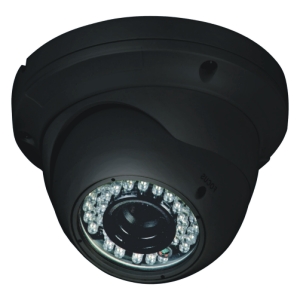 Security cameras utilize two basic lens types based on focusing parameters. These are called fixed lens cameras and varifocal cameras. Fixed lenses have a “fixed” or constant, unchangeable focal length while varifocal lenses have a focal length that can vary. A more familiar term used for electric powered varifocal lenses is a “Zoom” lens; we will concentrate on the varifocal type in the following article.
Security cameras utilize two basic lens types based on focusing parameters. These are called fixed lens cameras and varifocal cameras. Fixed lenses have a “fixed” or constant, unchangeable focal length while varifocal lenses have a focal length that can vary. A more familiar term used for electric powered varifocal lenses is a “Zoom” lens; we will concentrate on the varifocal type in the following article.
In addition to the focusing characteristics of the lens, light requirements must also be considered. The light that is allowed to penetrate through the lens and strike the electronic sensor chip is normally controlled by a mechanical device known as an “iris.” The iris may be fixed, manual, or automatic. This refers to how the iris makes the light opening, called the aperture, smaller or larger. The aperture is equivalent to the human eyeball’s pupil. In very low light settings the aperture needs to be open wide to allow enough light to strike the sensor chip. However, in bright light conditions, the aperture is very small to prevent too much light from flooding the sensor chip.
If a security camera is used indoors in a setting that has a constant intensity of adequate light (i.e., a store, a warehouse, or a well lit room), then a “Fixed Iris Lens” should perform adequately to serve your needs. But if the actual field of view may need to change to a tight shot and back again, a varifocal camera is the answer.
In settings where the light conditions can vary from dark to bright (i.e., outside or a camera aimed at an outside window) an “Auto Iris Lens” will be needed to compensate and adjust for the varying light levels.
Finally, in light conditions that are constant for long periods of time but change from dark to light or light to dark, a “Manual Iris Lens” can be used. These lenses’ apertures are changed by hand to provide the optimum light exposure.
Lenses are created using a combination of Fixed and Varifocal parameters with Fixed Iris, Auto Iris, or Manual Iris apertures. Most security camera lenses’ focal lengths vary from 3.6 mm to 16 mm for fixed focal length lenses, to well over 70mm for varifocal cameras. A short focal length will yield a wide angle of view and a long focal length will yield a narrow angle of view
The actual mathematical formula used to calculate the width and height of the area covered is Width = Camera Horizontal Format X Distance/Focal length and Height = Camera Vertical Format X Distance/Focal length.
In this formula, values for the Camera’s Horizontal and Vertical Format are the size of the CCD or CMOS chip expressed in MILLIMETERS, not inches, with the pictures aspect ratio of 4:3. For example, for a 1/3 inch CMOS chip the vertical size of the chip in mm is 3.7 mm and the horizontal size is 4.9 mm. Use the vertical format value of 3.7 mm to calculate height and the horizontal format value of 4.9 mm to calculate width.
Varifocal cameras are very versatile and easy to work with. There are different types of varifocal cameras just like there are different types of irises for cameras as described above. Some varifocal cameras are manual varifocal cameras which means you must physically change the focal length on the camera. Others are automatic and can be done through electronic controls associated with the DVR.
The key is to decide whether you will require a varifocal camera or not. A camera placed at the end of a fairly straight, long driveway would be a good candidate for a varifocal camera as you can zoom in on objects (like cars and people) at the end of the driveway but as the object comes up the driveway you can still keep them in focus and good view.
On the other hand, a camera pointed at a doorway to simply monitor the movement through the doorway would not need to be a varifocal camera; a fixed lens camera would suffice.
As a side note: Most all of the disguised or hidden cameras have 3.7 mm wide angle lenses and are fixed lenses. The lens on these cameras is made such that
there is the maximum amount of distance that stays in focus without the use of a varifocal camera.
If you have any questions regarding varifocal lens or varifocal cameras, contact one of our security experts today via on-line “Live Chat” or by telephone at 866-573-8878 Monday through Friday from 9AM to 6 PM EST.
